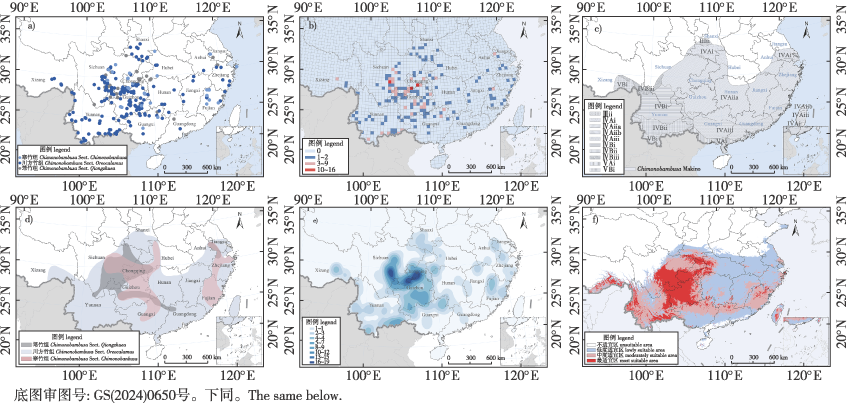 PDF(4509 KB)
PDF(4509 KB)


Spatial distribution characteristics and influencing factors of Chimonobambusa in China
ZHANG Yiting, XIA Nianhe, LIN Shuyan, DING Yulong
Journal of Nanjing Forestry University (Natural Sciences Edition) ›› 2025, Vol. 49 ›› Issue (2) : 107-114.
 PDF(4509 KB)
PDF(4509 KB)
 PDF(4509 KB)
PDF(4509 KB)
Spatial distribution characteristics and influencing factors of Chimonobambusa in China
【Objective】 This study elucidated the horizontal and vertical distribution patterns of Chimonobambusa in China. Using model simulation methods, we analyzes the key factors influencing its distribution, providing a scientific basis for the development, utilization, and conservation of Chimonobambusa germplasm resources.【Method】 The study employed the ArcGIS spatial analyst tools and the MaxEnt model, integrating eight environmental variables and 340 distribution records. We examined the spatial distribution, distribution types, density, species richness, and influencing factors of Chimonobambusa. 【Result】Chimonobambusa species are widely distributed, with their primary centers located in Yunnan, Guizhou, Sichuan, and Chongqing. They are predominantly found in the middle subtropical broadleaf evergreen forest northern subzone, with altitudes between 1 000 and 2 000 meters exhibiting the highest species diversity. Intrageneric differences in spatial distribution are significant. Model simulations reveal that precipitation and temperature are the primary factors limiting the distribution of Chimonobambusa. Furthermore, the potential distribution areas predicted by the model closely align with the actual observed distributions. 【Conclusion】 China possesses abundant Chimonobambusa resources, with their distribution strongly correlated with the country’s vegetation and climatic regionalization. These plants thrive in environments characterized by relatively low temperatures, humid climates, and high rainfall. The findings hold significant value for the sustainable development and conservation of local bamboo resources and the preservation of species diversity in China.

Chimonobambusa / ArcGIS / MaxEnt model / geographical distribution
| [1] |
|
| [2] |
|
| [3] |
薛纪如, 章伟平. 寒竹属[M]// 耿伯介, 王正平. 中国植物志: 第9卷第1分册. 北京: 科学出版社, 1996: 324-344.
|
| [4] |
|
| [5] |
|
| [6] |
|
| [7] |
|
| [8] |
|
| [9] |
冯鹏飞, 李玉敏. 2021年中国竹资源报告[J]. 世界竹藤通讯, 2023, 21(2); 100-103.
|
| [10] |
易同培, 史军义, 马丽莎. 中国竹类图志[M]. 北京: 科学出版社, 2008.
|
| [11] |
梁泰然. 中国竹林区划[J]. 河南农学院科技通讯, 1978, 12(1):96-123.
|
| [12] |
|
| [13] |
|
| [14] |
|
| [15] |
许祖昌, 罗亚皇, 秦声远, 等. 中国竹类植物馆藏标本现状与地理分布[J]. 生物多样性, 2021, 29(7): 897-909.
|
| [16] |
董苏君, 马松梅, 张丹, 等. 新疆猪毛菜属植物多样性地理分布格局及其环境解释[J]. 生态学报, 2023, 43(19): 8025-8034.
|
| [17] |
杨宏, 董京京, 吴桐, 等. 基于MaxEnt模型的迎春樱桃潜在适生区预测[J]. 南京林业大学学报(自然科学版), 2023, 47(4):131-138.
|
| [18] |
|
| [19] |
易同培. 中国竹类图志( 续-ⅡM]. 北京: 科学出版社, 2017.
|
| [20] |
王海涛, 史军义, 易同培, 等. 台湾的竹类植物及其特点[J]. 四川林业科技, 2007, 28(6):44-47.
|
| [21] |
中国植被编辑委员会. 中国植被[M]. 北京: 科学出版社,1980.
Editorial Committee of China Vegetation Editorial Committee. Chinese vegetation[M]. Beijing: Science Press,1980.
|
| [22] |
|
| [23] |
|
| [24] |
崔相艳, 王文娟, 杨小强, 等. 基于生态位模型预测野生油茶的潜在分布[J]. 生物多样性, 2016, 24(10):1117-1128.
|
| [25] |
|
| [26] |
|
| [27] |
张新时. 中华人民共和国植被图[M]. 北京: 地质出版社, 2007.
|
/
| 〈 |
|
〉 |